
More Recent 2023 Fishing Reports
Crappies 6-20 • Sundin 6-19 • Leech Lake 6-18 • Winnie 6-16 • LOW 6-13 • Sundin 6-12 • Upper Red 6-11 • Winnie June 9 • Sundin June 8 • Ely Area 6-7 • Winnie 6-1 • Rod Storage 5-31 • Lake Superior 5-11 • Walleye Stocking 5-3 • Walleye Stamp 3-3 • Forward Sonar • Panfish Workgroup • Follow on Facebook
 Jeff Sundin October 31, 2022 "Wrapping Up The Fishing Season; Again?"
Jeff Sundin October 31, 2022 "Wrapping Up The Fishing Season; Again?"
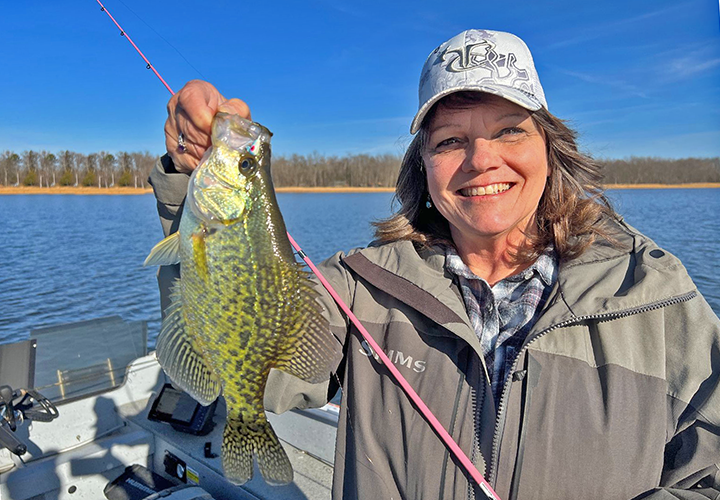 When Susan, AKA the Hippie Chick and I were fishing yesterday afternoon, she asked, “is this the latest date that I’d been fishing on open water? “No sweetie, I’ve been out later than this, but not often. I think maybe the latest trip might have been a day or two before, the deer season, November 4th, or 5th, give or take a day”; I answered. Disappointed by my reply, she asked, “how long will I need to be around until I am fishing with you on your latest open water trip ever?
When Susan, AKA the Hippie Chick and I were fishing yesterday afternoon, she asked, “is this the latest date that I’d been fishing on open water? “No sweetie, I’ve been out later than this, but not often. I think maybe the latest trip might have been a day or two before, the deer season, November 4th, or 5th, give or take a day”; I answered. Disappointed by my reply, she asked, “how long will I need to be around until I am fishing with you on your latest open water trip ever?
That’s a good question, but the way things have gone this year, anything is possible. As of yesterday, there are still docks in the water at public accesses at many of the more popular lakes in the area. In fact, I haven’t had to crawl over the gunnel of my Alaskan to get inside anywhere yet. Most lakes, like the one we fished yesterday, still have a handful of resident pontoons and fishing boats parked at docks or on boat lifts. Around the region, I still see folks trailering boats and yesterday, there were 3 or 4 other boats on the lake with us.
Water temperatures are relatively stable but have inched up a little bit since the last time I fished. The Humminbird registered readings between 46 and 49 degrees yesterday, 46.7 degrees was the most persistent.
 Crappies, our target species, were in almost identical places where we found them on the most recent trip, October 20th, 2022. The edges of breaklines leading into the mid-lake holes held the “better fish”. Focusing on small packs of crappies holding tighter to the structure offered a better opportunity for catching harvestable fish. The key depth for these scattered packs was 17 to 19 feet.
Crappies, our target species, were in almost identical places where we found them on the most recent trip, October 20th, 2022. The edges of breaklines leading into the mid-lake holes held the “better fish”. Focusing on small packs of crappies holding tighter to the structure offered a better opportunity for catching harvestable fish. The key depth for these scattered packs was 17 to 19 feet.
When I moved deeper, over 20 to 22 feet of water, I found many larger schools of fish. But when we fished those massive schools, we caught small fish, presumably from the 2016-year class that we’ve been discussing recently. At 6 to 8 inches long, those fish presented no real opportunity for us. So, despite the temptation to stop and fish for them, we’d learned quickly to skip over the larger schools and focus on finding those small packs instead.
Sometimes variations in presentation are called for, but not yesterday. Those fish wanted blue/glow, 1/8-ounce live Bait Jigs tipped with small fathead minnows. Not yellow, not 1/16 ounce, not tungsten ice jigs, not waxworms, not plastics, not tiny crappie minnows, not anything else. We did get some of the baby size fish using other lures, but the only keeper fish we caught came on that combination, blue/glow, 1/8-ounce live Bait Jigs tipped with small fathead minnows. That information may or may not be helpful later but keep it in mind just in case you locate fish that seem to be “not biting”.
A week ago, I sort of declared the end to my fishing season but left it open-ended. Because of Susan’s question about how late we might be able to fish, I won’t call this trip the last one either. But I’m remembering all of those years when we’d see ice forming on the shoreline by opening morning of the deer season and wondering myself, how long will the season last? Will the Hippie Chick get her wish and be the latest recorded fishing trip of any open water season?
I’m not sure how to get a direct response, but on the off chance that Mother Nature might see it, I’ll end with this, an open letter for her consideration.
Dear Natura, I know that we’re supposed to be checking off the list of fall chores, preparing for winter. But if you keep dangling beautiful days in front of everybody there are bound to be a few who get our boats back out of storage and go fishing. Powerless to fight the urge, we depend on you to save us from ourselves. So, if you really want us to be done with fishing for the season, please send back the cold air and snow, then we’ll put our boats away, (for real this time) and … get ready to go ice fishing instead! ![]() — Jeff Sundin 218-245-9858 or EMAIL
— Jeff Sundin 218-245-9858 or EMAIL
 Lake of the Woods, LOW Tourism October 25, 2022
Lake of the Woods, LOW Tourism October 25, 2022
 "It was another week, minus a couple of cold days, of great fall fishing on the south side of Lake of the woods. Schools of walleyes and saugers are set up in various locations along the south shore of Big Traverse Bay. Long Point area, Zippel Bay, Morris Point and Lighthouse Gap areas are still producing fish and anglers are catching a mixed bag of walleyes, saugers, pike, jumbo perch and an occasional crappie or sturgeon.
"It was another week, minus a couple of cold days, of great fall fishing on the south side of Lake of the woods. Schools of walleyes and saugers are set up in various locations along the south shore of Big Traverse Bay. Long Point area, Zippel Bay, Morris Point and Lighthouse Gap areas are still producing fish and anglers are catching a mixed bag of walleyes, saugers, pike, jumbo perch and an occasional crappie or sturgeon.
A good overall starting depth range has been 18 to 25 feet of water. Some of the fish are roaming the mud flats, while others are holding closer to adjacent structures. Anchored up and jigging with fatheads and frozen shiners is working well. Most anglers will anchor up and vertically jig over the side. If walleyes are in the area, they are normally moving around enough to find you.
Not all of the walleyes migrate into the Rainy River, some of these fish will stay where they are now and will be targeted later, when resorts get their ice fishing houses on the lake. Normally, ice shelters will be available during early to mid December, Mother Nature dependent of course.
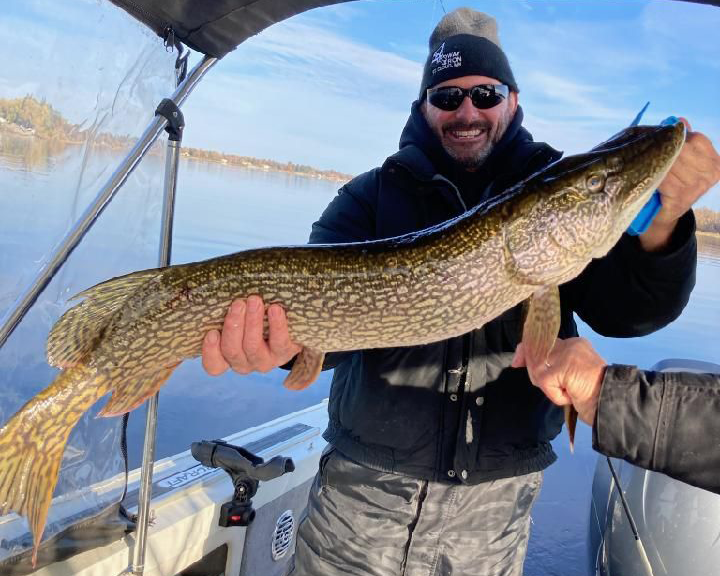 A great week of fall walleye fishing has been taking place on the Rainy River too. Boat ramps are open from Wheeler's Point to Baudette east to Birchdale.
A great week of fall walleye fishing has been taking place on the Rainy River too. Boat ramps are open from Wheeler's Point to Baudette east to Birchdale.
Traditionally, as we approach the end of October, some really big walleyes are caught. It might be getting colder and deer hunting is approaching, but seasoned hawg hunters know what this means on the Rainy. Recently, there were good fish caught both upstream and down, along various areas on the river. One day the bite is hot, the next day, its just okay. Who knows why that happens, but one thing's for sure, the fish are there.
Jigging with frozen shiners has been producing nicely. Gold, orange, chartreuse, glow white, pink or a combo of these colors are working well. Trolling crankbaits is also producing nice fish. Sturgeon are active too and some walleye anglers are taking a bit of their walleye time and fishing for dinosaurs. Some sturgeon caught by unsuspecting walleye anglers.
Walleye fishing is great up at the Northwest Angle too. This time of year, the mouth of bays can hold schools of shiners, which is a magnet for walleyes and other species. Points, rock islands, sunken islands, neck down areas, etc. are also holding fish.
Jigging with a minnow has been the go to method. Fish are in good numbers for anglers fishing either side of the border.
Big muskies are cooperating nicely for those pursuing them. In addition to working key structure, this is the time of the year trolling produces nicely. Resorts are busy getting fish houses, ice transportation and other winter equipment ready as ice fishing is just around the corner." — Lake of the Woods Tourism, (800) 382-FISH
 Jeff Sundin October 21, 2022 "More Pastel Shades of Fall Turnover"
Jeff Sundin October 21, 2022 "More Pastel Shades of Fall Turnover"
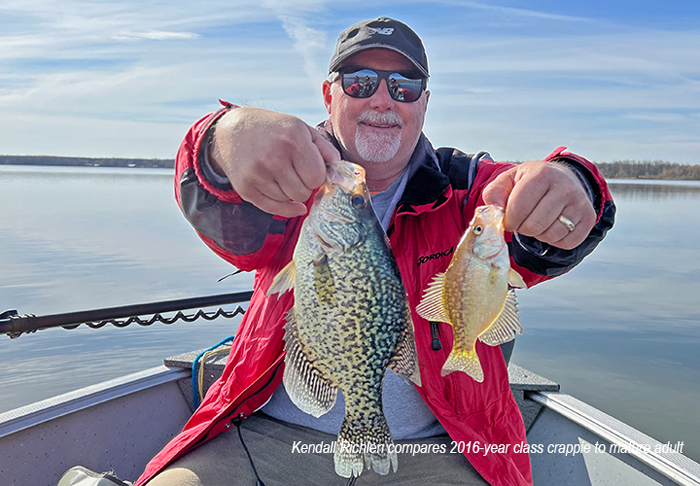 Do you believe that you can pin down the exact day that your favorite lake undergoes the “fall turnover”? If you can, you’re making better use of your grey matter than me, because I can’t do it.
Do you believe that you can pin down the exact day that your favorite lake undergoes the “fall turnover”? If you can, you’re making better use of your grey matter than me, because I can’t do it.
I am trying though and along the way, learning some valuable lessons about how to judge which phase of the turnover process a given lake might be in. Using the hard colors of my palette to create an image of “the turnover” provides less fidelity, I’m finding, than using pastels, and shades of grey to blend nuance into the painting.
I’ve learned over the past few days for instance that my report on October 13, 2022, offered the swashbuckling detail of an acrylic, but in some ways, lacked the character and definition of a fine watercolor painting. In it, I described accurately some of the technical differences between 2 lakes that I, along with John Landsberg and Eric Loge fished for crappies. There was one line in that report that bothered me all week long though. What it says is, “If those fish had been where they were supposed to be, releasing those small fish would have posed a problem. But instead of being stacked up in or near the lakes 50-foot-deep hole, those fish were spread out horizontally in 20 feet of water, high atop the sloping breakline”.
Technically, that sentence is correct because typically by mid-October, crappies in most lakes would have migrated into that hole, suspending over the lake’s deepest water. A panel of crappie fishing experts would likely agree that during most years, crappies would be that far along in the process by that time of the season. So, using the phrase “where they (the crappies) were supposed to be” was simplistic. Those fish aren’t really “supposed to be” anyplace, they are free to go wherever they want. A more accurate phrase might have been, “if those crappies were located where they typically would have been, based on my experience, at this point of most fishing seasons”. etc.
The reason, I understand now, that the crappies were not where I expected them to be that day was that the “turnover”, I mean the main event, the big one, must not have occurred yet. If a thermocline, causing stagnant, oxygen depleted water was keeping fish away from that deep hole, then their location along the shallower breaklines and mid-depth flats makes all the sense in the world. Those fish simply reacted to conditions, found the most comfortable places in those lakes and did whatever fish do with their free time.
So, why am I so smart now when I wasn’t a week ago? Because when I was preparing for yesterday’s fishing trip with Kendall and Julie Richlen, I explored another new (to me) crappie fishing lake and the crappies in that lake were in another phase of their fall transitions. Some were still spread out across flats in water depths of 19 to 21 feet, while others were stacked up along the breaks into the lake’s deepest holes at water depths of 26 to 29 feet. So, some of those crappies were located where I expected them to be in my story a week ago and some of them weren’t, but they were on their way. The surface water temperatures ranged between 44- and 45-degrees on the lake where that transition was occurring.
 Now I knew where the crappies were located and catching them was easy. The problem was that almost all of them were too small to be of interest to my fishing customers. That 2016-year class that I mentioned last week was very well represented, I caught dozens of them, but there appeared to be only a few older fish and even they were small, 9-1/2 to 10-1/2 inches was the largest example I could catch. So, I decided not to bother taking them to that lake, instead, I’d have to take an educated guess and go in cold to a lake that I haven’t fished since last year.
Now I knew where the crappies were located and catching them was easy. The problem was that almost all of them were too small to be of interest to my fishing customers. That 2016-year class that I mentioned last week was very well represented, I caught dozens of them, but there appeared to be only a few older fish and even they were small, 9-1/2 to 10-1/2 inches was the largest example I could catch. So, I decided not to bother taking them to that lake, instead, I’d have to take an educated guess and go in cold to a lake that I haven’t fished since last year.
I’ve described before the would-be profile of my ideal cold water crappie lake, not too deep, and not too complex. In terms of catching and releasing crappies, the water depth would be less than 30 feet maximum (when I can find that). In terms of exploration, the fewer the number of holes and prominent structures the better, maybe 2 or 3 mid-lake holes and 3 or 4 points or bars leading into them. So, in many ways, once I find any lake that fits “the profile”, fish location and presentations can be amazingly like each other.
In lakes that have them, crappies do migrate toward mid-lake, deep water basins, that’s common knowledge. If water clarity, average depth and plant life are similar, then depending on their geographic location and when waters cool to equal degrees, the timing for the migrations should be similar. Following guidance from almost any source, I’ve understood that water temperatures below 40 degrees would be a sure indication that fall turnover, the big one, would have occurred. So, when we arrived at the lake on Thursday morning and the surface water temperature was 39 degrees, I had a pretty good idea about where to look for the fish.
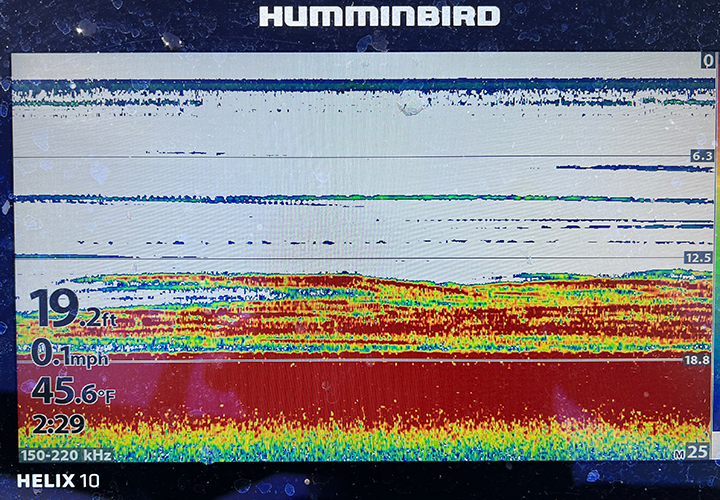 They were there too, stacked up along the upper edges of breaklines and suspended over the top of the lake’s deepest holes. In this case, the maximum depth was about 25 feet, and most of the fish were holding in water depths of 19 to 21 feet. Shallower than any of the lakes I’d fished recently, I had confidence that if we were to encounter many small crappies, catching and releasing them would be fairly safe.
They were there too, stacked up along the upper edges of breaklines and suspended over the top of the lake’s deepest holes. In this case, the maximum depth was about 25 feet, and most of the fish were holding in water depths of 19 to 21 feet. Shallower than any of the lakes I’d fished recently, I had confidence that if we were to encounter many small crappies, catching and releasing them would be fairly safe.
Ironically, the first crappie we caught was a beauty, 12 inches for sure, possibly 13 inches. Then we started catching the 2016s, one after another until it began to look like that’s all we were ever going to catch, so we left the area and started looking for walleyes.
From that point on, the screen of my Humminbird never registered a single fish in water shallower the 18 feet deep. Not a pike, a perch, or a walleye could be found anyplace in the shallows, nothing. So, I went back to the deepest water and targeted a submerged hump, hoping to find some walleyes. When we arrived, there were fish showing g up on the graph, and they looked larger, so we dropped our walleye jigs in the water and started catching crappies. The 2016-year class was well represented here too, but this time there were some better size fish blended into the mix, and about every 3rd or 4th fish would be a “keeper”. For us, that meant fish 11 inches or larger and although it took a while, we were able to maintain that standard and eventually, had all the crappies that Kendall and Julie could legally take.
We could have snooped around to see if we could drum up some walleyes or maybe sunnies, but with some bonus time on my hands, I offered a suggestion. “A friend of mine has been teasing us with pictures of walleyes that he’s catching on another lake. Do you want to head over there and see if we can catch a few of those before we wrap up for the day?” The idea sounded good to all of us, so we packed up the jalopy and headed over to my buddy’s home lake.
When we arrived there ... (continued Here) ![]() — Jeff Sundin 218-245-9858 or EMAIL
— Jeff Sundin 218-245-9858 or EMAIL
 Jeff Sundin October 21, 2022 "Beautiful End to a Fabulous Season"
Jeff Sundin October 21, 2022 "Beautiful End to a Fabulous Season"
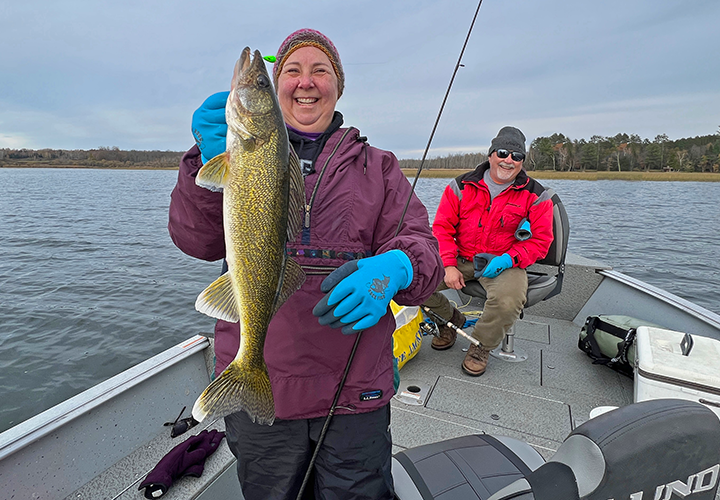 (continued from Crappie Report 10-21)
(continued from Crappie Report 10-21)
... When we arrived there, the parking lot was empty, and I could see that my buddy’s fishing boat was still parked at his dock. “I guess we won’t be accused of following the boats”, I said. “I did shoot a text message over to my friend to ask for any guidance he’d offer, but it looks like we’re on our own”, I concluded.
I picked a starting spot, a popular shoreline drop-off on the lake’s east side, the only place where the light breeze would offer us a drift. As we arrived there, the reply to my text inquiry came over the wire; “Jig and minnow, 19 to 21 feet of water, green is better than white”, it said. Both luckily and ironically, the location he suggested just happened to be the exact place where we were stopped. Great minds think alike, I guess.
Long story short, a little intuition along with a great amount of help from my friend gave us the chance to end the day with a nice finale. Julie caught her first “keeper” walleye of all time, and then caught a couple more too. I caught one larger fish that put a nice exclamation point on my fishing season, and there were a couple other ‘keepers” too.
That little run brought us to the finish line in style and at 6:00 PM, and as you can see in the accompanying image, the business part of my 2022 fishing season came to a most beautiful conclusion.
I am supposed to be happy that I have some time off, but I’m not. I would have been better off if the back of my hands were numb, and my eyes were shedding water from sleet pounding into them. If the weather was crummy, I could at least imagine how nice it might be to rest up for a while. Instead, all I have to remember is that beautiful sunset, my helpful pal and those gorgeous fish; what I am I supposed to do with that? Hmm .. We’ll see. ![]() — Jeff Sundin 218-245-9858 or EMAIL
— Jeff Sundin 218-245-9858 or EMAIL
 Jeff Sundin October 18, 2022 "Preparing the Prepare-Able"
Jeff Sundin October 18, 2022 "Preparing the Prepare-Able"
 It’s 19°F outside, the wind chimes have been clanging all night and my internal alarm clock rings at 5:00 AM. I already know that the last thing I’m going to do is go fishing, but I figure that I might as well head down to my basement office to start jotting down a few words. I get my cup of coffee, walk down the stairs and step into a pool of cold water. You might need a confab with Mrs. Sundin f you want to know exactly what I said, but as I recall, it wasn’t pleasant.
It’s 19°F outside, the wind chimes have been clanging all night and my internal alarm clock rings at 5:00 AM. I already know that the last thing I’m going to do is go fishing, but I figure that I might as well head down to my basement office to start jotting down a few words. I get my cup of coffee, walk down the stairs and step into a pool of cold water. You might need a confab with Mrs. Sundin f you want to know exactly what I said, but as I recall, it wasn’t pleasant.
While we’re sitting at the kitchen table searching for a new water heater, Mrs. Sundin says. “Last year on this date we were in heavenly bliss, fishing in the warm sunshine, catching walleyes.” “Seriously, a year ago today”, I asked? “Yup”, she replied, “October 17, 2021, you wrote the report yourself on the 18th, you can look it up if you want.”
It’s sort of ironic how after monitoring later than average weather progressions all summer long, they have now made up for lost time. In the past 10 days, weather progressions catapulted past some recent year’s benchmarks and could represent, if continued, an early freeze up. I won’t speculate about that today, but I will give it some thought as we roll along toward the deer hunting season.
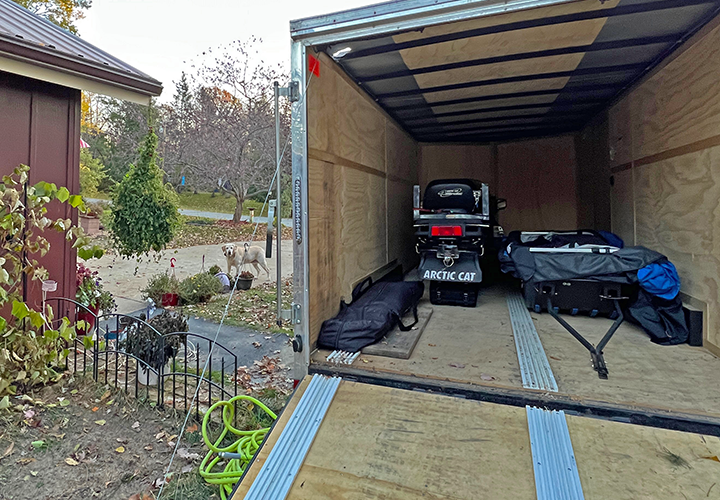 The cold and blustery weather took a bite out of my last week of fishing, a couple of trips were cancelled. Even if the water heater would not have conked out yesterday, there’s no way I would have gone on my scheduled reconnaissance fishing trip either, it was both too cold and too windy for that, at least for me.
The cold and blustery weather took a bite out of my last week of fishing, a couple of trips were cancelled. Even if the water heater would not have conked out yesterday, there’s no way I would have gone on my scheduled reconnaissance fishing trip either, it was both too cold and too windy for that, at least for me.
Today’s forecast is still cold, but a little bit more moderate, so after the new water heater gets installed, I might be able to slide out for a quick look at conditions on one of the nearby lakes. If not today, then tomorrow for sure, I’ll need to be on a lake somewhere, preparing for Thursday, my last scheduled fishing charter of this season. So, I’ll update whatever I can for folks watching the weather forecast and thinking about one last fishing trip this weekend.
After Thursday, my days in the boat are numbered. Family obligations will consume the weekend and my dog needs some exercise, so hopefully we can do a little bird hunting next week. And as you can see in the accompanying photo, there’s another fishing season opening soon and it looks like a good time to get ready for it, just saying. ![]() — Jeff Sundin 218-245-9858 or EMAIL
— Jeff Sundin 218-245-9858 or EMAIL
 Lake of the Woods, LOW Tourism October 18, 2022
Lake of the Woods, LOW Tourism October 18, 2022
 "Big Traverse Bay, along the south shore of Lake of the Woods is filling up with walleyes. Typical of most fall migrations, they are holding in various locations along the south shore and normally these fish will be at many of the same locations for the start of early ice fishing in December. Long Point area, Zippel Bay, Morris Point and Lighthouse Gap areas are all producing fish.
"Big Traverse Bay, along the south shore of Lake of the Woods is filling up with walleyes. Typical of most fall migrations, they are holding in various locations along the south shore and normally these fish will be at many of the same locations for the start of early ice fishing in December. Long Point area, Zippel Bay, Morris Point and Lighthouse Gap areas are all producing fish.
Anglers report a mixed bag of walleyes, saugers, pike, jumbo perch and an occasional crappie or sturgeon. Some walleyes are using structure while others are in the basin over mud. A good overall depth has been 20 to 25 feet of water. When fishing structure, the tops and sides of reefs have been effective. Anchored up and jigging with fatheads and frozen shiners is working well. Anchor your boat and vertically jig over the side. Give it 30 minutes and adjust to a new spot if there is little activity.
On the Rainy River, boat ramps are open from Wheeler's Point to Baudette and east to Birchdale. All of them have come in handy recently, and it was a great week of walleye fishing, despite some unpleasant weather systems moving through. Regardless of the weather, good fish were caught up and down the river. Larger fish were caught between Wheeler's Point and the International Bridge in Baudette. The walleyes are constantly moving, and the entire river is holding fish. Traditionally, some big fish move at the end of October.
Jigging with frozen shiners has been producing nicely. Gold, orange, chartreuse, glow white, pink or a combo of these colors work well. Cooler water temps are getting the sturgeon fired up too. Some big fish were caught again this week. With colder water, target holes in the river.
Up at the Northwest Angle, walleye fishing has been awesome all summer-fall and continues to be very good. Targeting high probability walleye areas such as points, rock islands, sunken islands, neck down areas, etc. is proving successful for most anglers. Jigging with a minnow has been the go-to method. Nice crappies, perch, pike and smallmouth bass are also active and being caught each day.
Muskies are cooperating nicely for those pursuing them. Working shorelines has been productive. Dropping water temps is leading to some incredible fall muskie fishing.
The upcoming week looks warm and dry, so anglers may get a chance to enjoy both good weather and good fishing at the same time!" — Lake of the Woods Tourism, (800) 382-FISH
 Jeff Sundin October 14, 2022 "Exploring the Explore-Able"
Jeff Sundin October 14, 2022 "Exploring the Explore-Able"
 By now, most of my readership audience have winterized their boats and have other, more timely outdoor pursuits besides fishing in mind. Still, there are always a handful of die-hard anglers who will be fishing right up until the ice begins to form along shore. For folks in this group, here’s what we have for you today.
By now, most of my readership audience have winterized their boats and have other, more timely outdoor pursuits besides fishing in mind. Still, there are always a handful of die-hard anglers who will be fishing right up until the ice begins to form along shore. For folks in this group, here’s what we have for you today.
There’s about ½ inch of snow in my yard right now and the forecast calls for a little bit more, maybe another inch before the day is over. The overnight low temperature in Grand Rapids was 32 degrees and if we’re lucky, the high today might reach 38 degrees.
The group I had scheduled for today was interested in “one last day” on the water and they’d still like that: just not on this day. So, you can either count me in the group of “die hards”, or the nut-jobs, or if you prefer, devoted fishing guides who still have work to do and need to use their free time for research, even if the temperatures are near freezing. No matter how it’s characterized, it’s an opportunity to learn more and be better prepared for the future. The good news is that calm wind is predicted today, that’s a blessing and helps explain why I’m actually preparing to go fishing myself today, but not for walleyes.
Early next week, I’ll turn my attention back to walleyes, but only because my customers will want them. For me personally, the walleye season is over and I’m ready to pursue any other gamefish. If they’re legal to catch, I’m in; just as long as they don’t have white tails. That said, if you’re interested in walleyes, maybe perch too, this would be a good time to look over the Mississippi River. As the waters cool and walleye action slows down in the lakes, activity begins ramping up on the river.
There are productive stretches lying between Little Winnie and Deer River. From Grand Rapids upstream, you’ll find more good pools that can be productive walleye spots. There are also good stretches of river in the Bemidji area, upstream from Big Sandy Lake and almost any place from Brainerd on downstream.
The Rainy River too, already popular as a fall walleye destination, has begun producing better than average action. Over the past few seasons, walleyes have made folks wait until later in the season, but this year the shiners moved in earlier, walleyes followed them, and anglers have begun catching them “ahead of schedule”. Arguably, the Rainy gets even better, later in the season, even into November, but if the bite is on, why not make your first trip earlier this season.
Walleye action on Lake Winnie was already in decline earlier this week. There were still fish biting, but the action was spotty, and anglers had to know more about both locating and getting them to bite. But as Winnie walleye action was slowing, Cutfoot Sioux, historically better during fall, was improving. Today, fishing for walleye on Cutfoot offers better odds than heading out to the big lake; I think.
Surface temperatures are well below 50 on the big lake, just above 50 on Cutfoot. When the water gets this cold, remember that fishing in the last hour of daylight can be helpful. In fact, there have been days when fishing the evening bite saved my butt after a slow day. Use the daytime hours to assess the spots where you see the most fish, pick up as many as you can along the way, but be ready to pick one spot where you’ll be all in at sunset; it works.
Leech Lake, despite living in Winnie's shadow this season has been productive too, especially for anglers fishing on the west side. By all accounts, both walleye and perch activity has been good, at least up to earlier this week. I'm short on specifics, but Leech might be worth considering, do your own research and decide for yourself.
Frequent readers know that researching crappie lakes during the late fall has become my passion over the past few seasons. Not only is it a good time to learn about fresh territory but is a good time to begin planning for the upcoming ice fishing season. So, that’s what I’m planning for today, only this time, instead of driving west, or north, I’m headed south. There are a handful of lakes in the Aitkin area that I’ve been chomping at the bit to check out, and today I have the chance.
Growing up, Aitkin was almost always the epicenter of our family fishing vacations. Lakes like Hanging Kettle, Spirit, Lone and others all had “mom and pop” resorts where we slept whenever we weren’t drowning angle worms with our cane poles. Eventually, my folks bought a cabin on Little Pine Lake and that, along with connected Farm Island Lake, became headquarters for slightly more advanced, but still rudimentary fishing adventures. Anyway, it always feels good to re-visit the area and I’m glad for the opportunity to do it again. Whatever happens, I’ll fill you in. ![]() — Jeff Sundin 218-245-9858 or EMAIL
— Jeff Sundin 218-245-9858 or EMAIL
 Jeff Sundin • Fall CRAPPIE Fishing • "I Been In The Right Month, But It Must Have Been The Wrong Year!" October 13, 2022
Jeff Sundin • Fall CRAPPIE Fishing • "I Been In The Right Month, But It Must Have Been The Wrong Year!" October 13, 2022
 In 1973, I was entering my senior year at Roosevelt High School in Minneapolis and, like many, heavily influenced by music. Take Dr. John's recording "Right Place, Wrong Time" for example, it was released that year and it stuck with me. I'll bet I've hummed that song in my head twice a week, maybe more, ever since. Oops, that can't be right, quick math tells us that's only 458 times, a definite misunderestimate, I've probably sung it at least 1000 times in the boat alone, just while I've been fishing, like yesterday.
In 1973, I was entering my senior year at Roosevelt High School in Minneapolis and, like many, heavily influenced by music. Take Dr. John's recording "Right Place, Wrong Time" for example, it was released that year and it stuck with me. I'll bet I've hummed that song in my head twice a week, maybe more, ever since. Oops, that can't be right, quick math tells us that's only 458 times, a definite misunderestimate, I've probably sung it at least 1000 times in the boat alone, just while I've been fishing, like yesterday.
Typically, today’s fishing report would contain information pertaining mostly to yesterday’s fishing trip and it will, but because of a reader question that arrived by email, I’m going to work backward. It’s not often that questions are so directly pertinent to my current fishing experiences, but this one is so timely that it only makes sense to start by answering the question first, then chronicling what we did yesterday.
 Crappies, Are There Some "Small Fish Lakes"?
Crappies, Are There Some "Small Fish Lakes"?
On October 8, 2022"Craig Bowron, St. Paul, MN wrote,
“When discussing crappie lakes, it's not uncommon to hear someone say, "Yeah, there's crappie in Lake Z, but they're always on the small side.” And in fact, I've been on lakes where that seemed to be the case.
Do you think that's true about some crappie lakes, and if so, are you inclined to think it has to do with the unique genetics of the crappies in that lake, or the particulars of the lake (spawning habitat, forage etc.), or perhaps the way that crappies are harvested on that lake? Clarify away! Thank you, Craig Bowron, St. Paul, MN.
Craig, the short answer is no, I do not believe genetics has much to do with most lakes’ ability to produce larger crappies. Like you, I’ve heard stories about lakes that are supposedly “little fish lakes”. In almost every instance, those lakes, when given time, will produce larger fish. Most of the time, all the lakes need is for us anglers to leave the fish alone until they reach larger sizes. That said, habitat and environment are considerations that can throw off the angler pressure, boom, bust, boom equation.
Fish of all species need room to grow, in fact space is more important to future growth than food is. There are some lakes that have so much good spawning habitat that fish can reproduce most years, if not all. In lakes like these, fish populations can become so strong that they don’t all have enough room to grow. So, stunted fish caused by over-crowding could be perceived as genetically related. But if you relocated some of the individual fish to lakes with more space, they’d likely grow larger.
Some lakes have relatively little spawing habitat, and with lower overall crappie populations, they can produce a handful of crappies that achieve much larger sizes than their cousins, living in lakes with more crowded conditions. Either way, angling pressure eventually enters the equation again.
Lakes with few crappies, even if they're bigger fish, don't get much attention from anglers. Although those lakes may be known to produce larger fish, anglers often have trouble locating them and therefore turn their attentrioin to lakes knoiwn to have higher populations. When everything is in balance, they can usually find a lake where both numbers and quality size can be obtained.
Because lakes with the most crappies get the most attention, anglers sometimes locate fish and begin harvesting them prematurely. This fall, some folks are keeping crappies the minute they become even remotely desirable to eat. “I can’t believe how small some of the crappies are that people have been bringing in," said the AIS inspector at the Mosomo Public Access at Little Cutfoot just last week. “Folks are keeping 7-to-9-inch crappie, I think mostly because they’re not getting many larger ones,” he concluded.
Cutfoot Sioux and Little Cutfoot Sioux are arguably two of the most popular crappie fishing destinations in north central Minnesota and most of the time, there are plenty of larger size fish to go around. Occasionally though, they undergo periods of intense pressure, the lakes production can’t keep up with demand and the re-building process begins. If anglers based their opinions about crappie populations on the experiences they had this fall, then both of those lakes could be characterized as “small fish lakes”. If enough of the small fish reach larger sizes, the Cutfoot lakes will eventually regain their reputations as destination crappie fishing lakes that offer opportunities for good size fish.
Crappies are in the doldrums in north central Minnesota’s Itasca Region, that’s not just my opinion, there are DNR fisheries biologists who agree. “There was good hatch in 2016 and it was widespread, but there were some lean years leading up to that, ones where crappie recruitment was minimal.” says a friend who works for the DNR in the Bemidji area; others have echoed the thought. “Not every lake was affected, as usual, there are outliers, but in a lot of lakes, the gap between larger “keeper” fish and the smaller 2016 crappies is noticeable,” another Grand Rapids area fisheries staff noted.
What that means is that as we anglers discovered and depleted the adult crappie populations in many of the region’s better crappie lakes and nature lagged in replenishing them. Today’s hopeful news is that there are better seasons ahead because that strong 2016-year class is reaching maturity and there are lots of lakes with strong populations of young crappies that will enter the keeper zone in another season or two. Right now, most of the 2016 crappies measure 6 to 8 inches in length, some are slightly larger, or smaller, depending on each individual lake’s growth rate.
We could go on for a long time about the nuances and fine points but suffice to say that in most of the state’s better crappie lakes, fish do have the ability to grow to desirable sizes. The anecdotal story about folks catching them in Cutfoot isn’t unique, it is going on in lakes almost everywhere throughout the Itasca region. That leads back to my theme, right-place-wrong-time and how it applied to our crappie fishing trip on Wednesday, 10-12-2022.
It started a while back with an email from customer and friend John Landsburg. He likes to fish for crappies in the fall, and in the past, we’ve explored other lakes together. This time wasn’t much different except that there was a list of specific lakes included in his request. When I started researching those lakes, fisheries surveys and DNR reports all had one thing in common, few if any crappies were caught in testing and none of the reports suggested that crappies were significant in terms of management goals. Maybe someday when I have freer time, we’ll try some of them, just for fun, but without better information to go on, these lakes were temporarily ruled out.
Starting with the DNR Recreation Compass, I began searching for other lakes in the region that might offer better odds for finding crappies. The recreation compass is handy because it features an interactive map that allows me to simply click on any lake and be re-directed to the DNR Lake Finder page for that specific lake. Fisheries surveys, aquatic vegetation reports, depth maps and management goals are just a few of the useful tidbits I read about each lake. I’ll never claim that all the information is spot-on because it can sometimes become outdated. But I will say that their reports often give me a thumbs up or down regarding whether I will endeavor to study them more thoroughly.
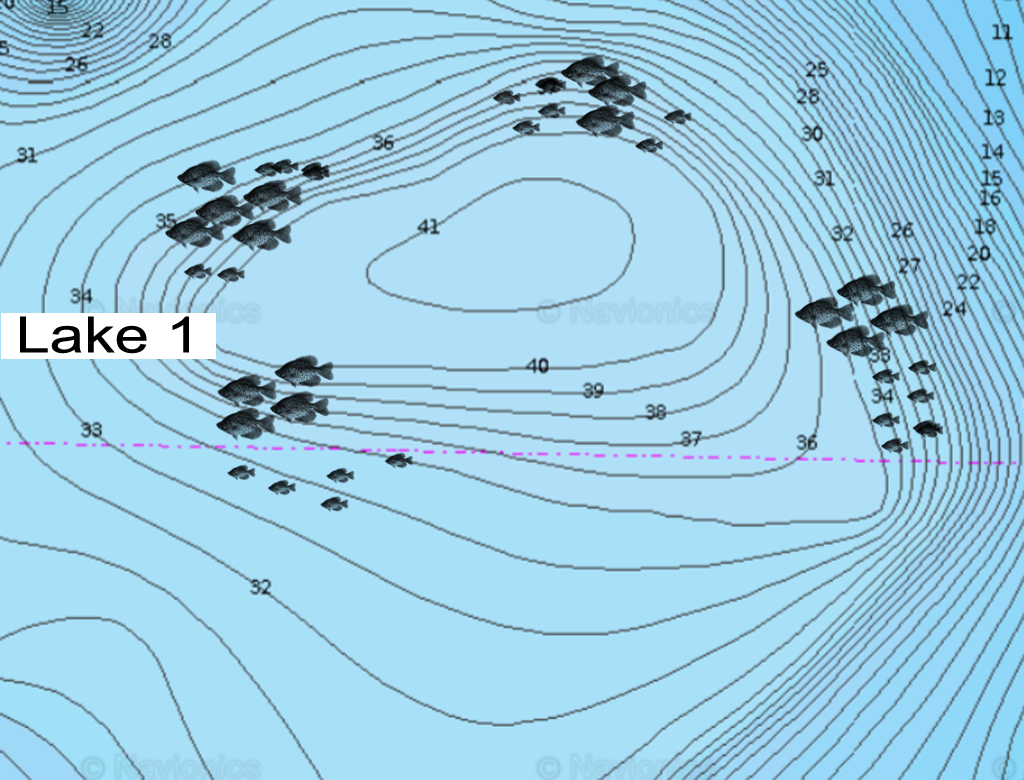 After narrowing down choices in John’s target area and giving them, some thought, I offered a couple of alternative lakes. One of them, near Bemidji, the other near Walker, I’d been on both before, but not many times. So, the term experimental applied to my choices, albeit based on educated guesses.
After narrowing down choices in John’s target area and giving them, some thought, I offered a couple of alternative lakes. One of them, near Bemidji, the other near Walker, I’d been on both before, but not many times. So, the term experimental applied to my choices, albeit based on educated guesses.
Lake 1 was a pretty good fit for my preferred cold water crappie lake profile. It had one hole with a maximum depth of 35 feet, a little deeper than I’d like, but not horrible either. Unless the fish were located dead center of the deepest water, odds were good that releasing some of the smaller ones would be acceptable.
Lake 2, “the backup plan”, was a deeper lake, but was like Lake 1 in that it too was a simple one-hole lake, with flats surrounding the deep basin, Lake 1 was also reported to have larger crappies. In case of emergency, I could maybe get some eaters there, without having to attempt releasing any, especially if we were forced to fish deeper water, I reasoned.
Ironically, we would wind up fishing both of the lakes in the same day and in both cases, the “profile” would turn out to be wrong.
Lake 1 should have been the only stop we made for crappies. They were easy to locate, in fact on our 2nd stop, a slow tapering breakline leading toward the lake’s deep basin, we experienced a flurry of action. Some of those fish were too small and some of them were okay, measuring 10 to 11 inches. The problem was that whitecaps on top of 1-foot rollers were making it hard to stay on top of them. The best I could do was find them, hold still for a minute, maybe catch 1 or 2, and then watch the small schools dissipate.
Surface water on Lake 1 was 56 degrees and some of those fish should have been on the flats, instead of over the deep hole. However, if there were fish in calmer water, on the flats, a half hour search didn’t reveal them. So, instead of making it a day long battle with the whitecaps, we moved to the backup plan, Lake 2.
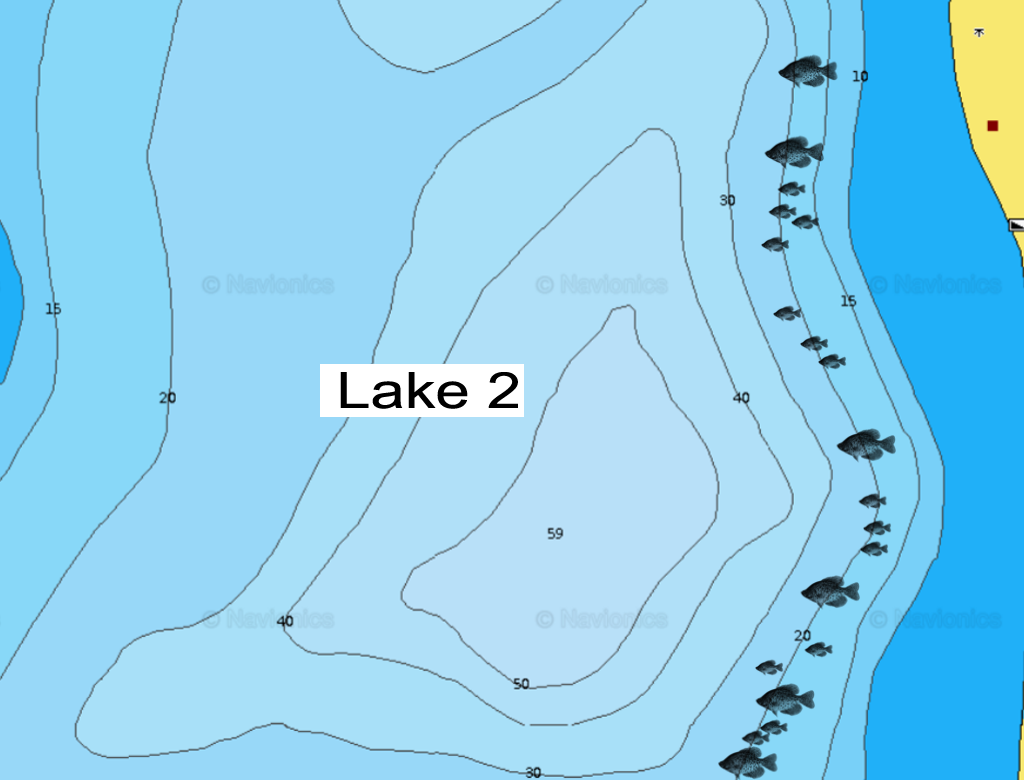 If we’d gone there first, lake 2 might have been our only stop for crappies yesterday too. But we weren’t there long enough for that. I think we could have gathered 2 limits of nice fish, but it would have taken a few extra hours to cover all of territory necessary to do that. That’s because on Lake 2, we got a full-strength dosage of the re-building population of 2016 year class crappies. At 6 to 8 inches long, they were plentiful, but not large enough to be of interest. Occasionally, maybe every 5th or 6th fish, we’d catch a keeper, almost all of those were 11 to 11-1/2 inches and appeared to also be from a single year class.
If we’d gone there first, lake 2 might have been our only stop for crappies yesterday too. But we weren’t there long enough for that. I think we could have gathered 2 limits of nice fish, but it would have taken a few extra hours to cover all of territory necessary to do that. That’s because on Lake 2, we got a full-strength dosage of the re-building population of 2016 year class crappies. At 6 to 8 inches long, they were plentiful, but not large enough to be of interest. Occasionally, maybe every 5th or 6th fish, we’d catch a keeper, almost all of those were 11 to 11-1/2 inches and appeared to also be from a single year class.
If those fish had been where they were supposed to be, releasing those small fish would have posed a problem. But instead of being stacked up in or near the lakes 50-foot-deep hole, those fish were spread out horizontally in 20 feet of water, high atop the sloping breakline. Trolling the break at .3 to .4 MPH and only catching 1 keeper per every half dozen fish adds up to a slow grind. But if we’d done it all day long, those 20 crappies I mentioned would likely have been gathered. As it happened, we harvested 9 fish that were clearly keepers. We released a few marginal fish that some folks would have kept too, but all of the rest were way too small for harvesting this year.
Presentations won’t surprise you. We caught some of the fish using small jigging Raps, a few more on 1/8-ounce Live Bait Jigs tipped with minnows and a couple of larger fish using the same 1/8-ounce jig tipped with a half nightcrawler. I was trying to use the crawlers to locate sunfish, but only caught crappies on them, unusual, but not unheard of, in my experience.
The upshots of today’s report are these, I guess. Late fall is a good time to research new lakes and if you do your homework, you’ll probably be rewarded. But even when you do find new crappie water, you might find that there are a lot of small fish in the mix. If both of those things happen, you might be tempted to mis-identify your newly discovered lake as a “small fish lake” and that might be a mistake.
“I been in the right place, but it must have been the wrong time”; you can see why that song came to mind yesterday. I’ve decided that my timing for researching new lakes is a little bit off. Truly knowing the upside potential of yesterday’s 2 new crappie spots is going to take a couple of years. If those small, 2016-year class fish survive the angling pressure this winter, and then make it through next summer, and then they live again thorough next fall, and then are able steer clear of anglers over next winter again; I might be on to something. Then we might go back and be in the right place at the right time.
In the meantime, I’ll keep the search for “new water” going and do my best not to be the one that over-does the fishing pressure on any 1 lake. That’s the best any of us can do. ![]() — Jeff Sundin 218-245-9858 or EMAIL
— Jeff Sundin 218-245-9858 or EMAIL
 Ely Area, Arrowhead Outdoors Fishing Report October 13, 2022
Ely Area, Arrowhead Outdoors Fishing Report October 13, 2022
 "Walleye fishing continues to be good for anglers still chasing them. 10 feet of water or less also continues to be where the best reports keep coming from. Up here bigger minnows like creek chubs and or pike suckers has been the bait of choice. Tipping them on a light jig or lindy rigging them has been very effective. Weedbeds, points and river mouths are where walleyes have been hanging out.
"Walleye fishing continues to be good for anglers still chasing them. 10 feet of water or less also continues to be where the best reports keep coming from. Up here bigger minnows like creek chubs and or pike suckers has been the bait of choice. Tipping them on a light jig or lindy rigging them has been very effective. Weedbeds, points and river mouths are where walleyes have been hanging out.
Northern Pike fishing is where the best fishing has been this last week. That cold snap really has the big pike up shallow and very aggressive right now. Big suckers and the biggest creek chubs you can find, has been deadly. River mouths have been the best areas to find pike right now, but large rocky points and any green weeds you can find, is where anglers are finding the pike.
Smallmouth Bass have really started to put on the feed bag right now. Find any sunken island and drop a big minnow on it, your going to get bit, quickly! Bigger minnows will help keep off smaller smallies, so don’t be shy to drop a 8” minnow down there!" — Arrowhead Outdoors, 218-365-5358
 Lake of the Woods, LOW Tourism October 11, 2022
Lake of the Woods, LOW Tourism October 11, 2022
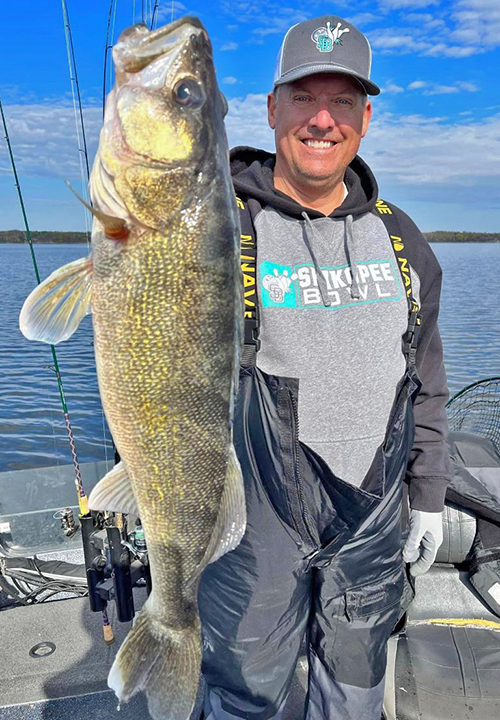 "Scattered schools of walleyes are being found in various areas along the south shore of Lake of the Woods and, when located, have provided some very good fall fishing on the big lake. Anglers report finding them anywhere from Long Point to Zippel Bay to Morris Point Gap over to Lighthouse Gap. There are also other fish present and they create opportunities for a “ mixed bag” of walleyes, saugers, pike, jumbo perch and an occasional crappie or sturgeon.
"Scattered schools of walleyes are being found in various areas along the south shore of Lake of the Woods and, when located, have provided some very good fall fishing on the big lake. Anglers report finding them anywhere from Long Point to Zippel Bay to Morris Point Gap over to Lighthouse Gap. There are also other fish present and they create opportunities for a “ mixed bag” of walleyes, saugers, pike, jumbo perch and an occasional crappie or sturgeon.
Some of the schools of fish are more active than others, so even when scoping lots of fish with electronics, angler judgement about how long to remain in an area is a key to success. Most anglers are finding walleyes that will cooperate now and the belief is that walleye action will continue to get even better with cooling water temps. Charter boats are on good schools of walleyes and will be fishing through October.
Best, or least the most common presentation is anchoring and vertical jigging with fatheads and/or frozen shiners. Slide the hook of the jig through the mouth of the minnow, out the gills and as far back as possible, putting the hook through the minnow about half way back on the minnow. This will get you more hook ups with light biting walleyes and saugers.
Jig colors, try strobe gold (like a disco ball) or plain gold combined with orange, glow white, glow red, pink or chartreuse.
There are more and more shiners moving into the Rainy River this week, as did more walleyes. Most are finding fish and going through a lot of bait. If you aren't finding fish, move until you do. They are around and we’ve heard good reports from Four Mile Bay to Baudette and east to Frontier and Birchdale. Boat ramps are open all the way from Wheeler's Point to Baudette east to Birchdale.
Jigging with frozen shiners is the most common technique, especially when fishing structure. Trolling crankbaits upstream in the river is also catching some nice walleyes. Cooler water temps are getting the sturgeon active. Some big fish were caught again this week. With colder water, target holes in the river.
Walleye fishing continues to be really good up at the Northwest Angle as well. Jigging with a minnow or plastic is catching good numbers of fish on both sides of the border.
Anglers are targeting structures for most walleyes. Points, rock islands, sunken islands, neck down areas, etc. Big northern pike have also been caught by unsuspecting walleye anglers at the same time. Muskie activity was good again this week too. Casting shorelines has been productive and with cooling water, trolling shorelines will soon be effective.
As of October 1, 2022, being vaccinated for COVID is no longer required to enter Canada. In addition, the ArriveCan app is not required, but optional. Perfect timing for the rest of the fall and the ice fishing season." — Lake of the Woods Tourism, (800) 382-FISH
 Turning the Turn-Able — "Is My Timing Off For Winnie Walleye Fall Trip?" October 8, 2022
Turning the Turn-Able — "Is My Timing Off For Winnie Walleye Fall Trip?" October 8, 2022
Yesterday I wrote, “Today’s test might be a different one. Were the overnight low air temperatures in the 30s be enough to plunge water temperatures into the danger zone? At 57 degrees, walleyes were still “biting” even if they were hard to pin down. Today’s fish activity depends on whether the lake held onto enough warmth to encourage the continuation of what was a very strong fall feeding binge earlier this week.”
Obviously, the fish were still biting yesterday, but how long will it last and what happens later, after the slow-down occurs? That’s the theme of this question Steve Lewis who wrote, “Hi Jeff, Thanks so much for continuing to fish and report late into the season! I am coming up to Winnie starting next week. Reading your fall turnover report, it makes me wonder, am I coming up too late to have decent walleye fishing? I pushed out later this year because last year was so warm in the fall and wanted a true colder weather experience. Now second guessing. At any rate might see you out there next week!”
Steve, timing any fishing trip for absolute peak of the fall walleye runs is always tricky and I think you’re right, last year, the warmer weather did linger longer than usual. I have learned though that no matter what, every season is different. Seasonal trends do repeat themselves, but I can’t think of a single time in the past 37 years that any two fishing seasons followed the same timeline. That means that the best you can do is plan your fishing trip for what could be a good “average” time for walleye action and if the action falls off during your stay, adjust as best you can to the conditions you face at the time.
Last year, most every one of the crews that fished with me in October enjoyed great fishing. My season was on the trajectory of a strong finish and with one last trip on the calendar, the ship hit the sand. On October 16, 2021, Bugs Benton, Kurt Seger, and I fished long and hard to come up with a total catch of 8 walleyes on Winnie. That wasn’t a horrible catch, but in the aftermath or what had been “a hot bite”, felt disappointing at the time. That day will come again and soon, that’s for sure, but none of us knows exactly which day it will happen.
Reading my reports from last fall, your concern about being off on the timing of this year’s fishing trip are understandable. On October 8, 2021, I wrote, “Surface water temperatures are holding steady at about 63 degrees. Hearty vegetation like cabbage and coontail are still green, healthy, and holding lots of baitfish.”
Yesterday, surface temperatures were 55 to 56 degrees and while there were still some green weeds, there were also piles of decayed and dying weeds laying along the shoreline. This is not an exact science but for me, water temperatures below 55 degrees keep me awake at night. That’s when I start worrying about the annual fall “slow-down”, but it doesn’t always happen immediately. We’ve experienced good fishing at 54 degrees, 53 degrees and sometime even colder if the local conditions favor a period of strong feeding activity. If the weather breaks in your favor, walleye fishing could be awesome, even on days when it doesn’t seem likely.
Remember that what happens on one lake does not automatically happen on every lake. So, even if you’re visiting one that’s recently undergone one of these pre-turnover periods, there are likely others in the region where fish are still active. Likewise, fish activity does not end permanently, during this period, it is only interrupted by a shakeup in the lake’s ecosystem. In fact, in my experience, the fish do not stop biting, they just scatter and become more difficult to pin down. If you haven’t already, read the report from October 18, 2021, I think it will be helpful.
Fishing at prime time is another way to mitigate the effects of these mini-turnover scattering events. Even though fish may be harder to locate during the day, they are hungry and will make short-but-intense feeding runs at sunset. Think of it as the earliest phase of the ice fishing season when we often experience the fish’s propensity for making crepuscular period feeding runs.
Up against the clock, I hope that I’ve allowed enough time to answer your question. If not, follow up as needed, but in the meantime, come on up and enjoy your time on the water. Timing is timing and if you’re off this season, then adapt as best you can. Success is easy, but seldom helpful in terms of improving our skills, tough fought battles on the water are how the best lessons are learned. If you come seeking knowledge, you’re going to be rewarded, trust me, I know. ![]() — Office Cell Call or Text 218-245-9858 or EMAIL
— Office Cell Call or Text 218-245-9858 or EMAIL
 Wired2Fish "6 Spinnerbait Tips to Catch More Fall Smallmouth Bass"
Wired2Fish "6 Spinnerbait Tips to Catch More Fall Smallmouth Bass"
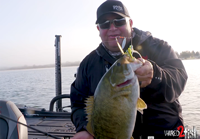 "Wired2fish caught up with Bill Lowen for a lesson on finding and catching shallow water smallmouth bass using spinnerbaits during the fall. While deeper offshore structure makes prime smallmouth habitat, the shallows always hold fish, particularly during the spring and fall. A fast-moving spinnerbait bulged just below the surface is tailor-made to imitate a small school of baitfish and excels at combining vast flats and triggering reaction strikes. *Product links at the bottom.
"Wired2fish caught up with Bill Lowen for a lesson on finding and catching shallow water smallmouth bass using spinnerbaits during the fall. While deeper offshore structure makes prime smallmouth habitat, the shallows always hold fish, particularly during the spring and fall. A fast-moving spinnerbait bulged just below the surface is tailor-made to imitate a small school of baitfish and excels at combining vast flats and triggering reaction strikes. *Product links at the bottom.
Here are Lowen’s 6 tips to dial the bite:
- Burn (speed reel) spinnerbaits just under the surface. Bass in clear water feed by sight — a fast retrieve prevents fish from inspecting the bait and forces a reaction strike. It’s also among the best methods for combining vast expanses of water in search of scattered bass.
- Always ... View Video and Learn More >> 6 Spinnerbait Tips to Catch More Fall Smallmouth Bass
 Jeff Sundin "All In All, It's Just Another Brick (of humility) In The Wall" October 7, 2022
Jeff Sundin "All In All, It's Just Another Brick (of humility) In The Wall" October 7, 2022
Thursday wasn’t a lot of fun on the lake, 40-degree air temperatures added a bite to the strong north winds. Large whitecaps delineated a “no go zone” that covered every part of Winnie except for the extreme north shoreline. Cutfoot, to a lesser extent, offered the same conditions, calm water to the north, whitecaps, and cold winds to the south. “Die-Hard” anglers, there were a few, lined up along north side of the big lake, more casual anglers crammed into whatever space they could find in Little Cutfoot.
Surface water temperatures on the north side of Winnie held steady at 57 degrees and did not appear to have moved fish out of the shallow weeds and/or shoreline breaks. Friends reported that they were catching good numbers of both walleye and perch in water depths of 6 to 7 feet. I was late to that party and found only a couple of small fish that shallow. There was a line of fish in deeper water though, and we managed to pick up some of those by working the 10 to 12 breakline. Walleyes, mixed with some small pike made up the lion’s share of the population, we did not catch perch on the deeper breaks.
A true north wind is unusual up here, but it was dead straight out of the north yesterday and perpendicular to the shoreline. So, while we were comfortable, relatively warm, and dry, boat control was still an issue. I’d argue that calm water or not, this strong offshore wind scenario causes more grey hair for this coxswain than almost any other fishing situation. So, during mid-afternoon when the wind calmed down a little bit, I began thinking about relieving my crew of their struggle to maintain contact with their lures that the offshore wind had caused.
Combined with the memories of catching lots of walleye and perch on Winnie’s west side earlier this week, the urge to “make a move” had overtaken me. I motored over to Mallard point and there we began proving the mistake I’d made. One walleye caught within minutes of beginning the first drift added encouragement, but from then on, we would not see another walleye. To be fair, I ran out of time before I could check many of the potentially better spots, but that didn’t change the result.
Looking back, I’d have been better off grinding away at the school of fish I’d found up north. Sometimes even slow fishing is good fishing when it combines comfort with even a little bit of success. My problem is that I fall into the trap of thinking that I can find something better, sometimes I do, but not always. So, add one more brick of humility to the wall that’s been under construction around my palatial estate, if I keep up the good work, it should be completed soon!
Luckily for me, I have the same crew today, and again tomorrow. We did get enough walleyes yesterday to provide for a fish fry tonight, so dinner is already covered. That gives me 2 days to come up with a stronger, less defensive game plan and provide the boys with a strong finish to their 2022 fishing seasons.
Today’s test might be a different one. Were the overnight low air temperatures in the 30s be enough to plunge water temperatures into the danger zone? At 57 degrees, walleyes were still “biting” even if they were hard to pin down. Today’s fish activity depends on whether or not the lake held onto enough warmth to encourage the continuation of what was a very strong fall feeding binge earlier this week.
You may recall past conversations about the fall turnover, why it occurs and how it affects fishing. If you haven’t, I’d encourage you to follow these links to more informative articles.
- Fishing Fall Turnover In Natural Lakes Print Artile by Jeff Sundin August 2022
- Jeff Sundin on Fall Lake Turnover KAXE Radio Interview With Sundin October 2020
If you’ve already read them, then recall one of the ways we can tell that the action is about to stop. When you experience a brief period where the fishing action is so good that you can’t make a mistake. Walleyes, perch and other fish seem to be jumping in the boat as fast as you can drop lines in the water. Soon afterward, whatever the trigger is, the action stops, sometimes overnight and the difference is stark. Last year, that did not occur for me until October 16, 2021, so I'm cautiously optimistic that we'll be "okay" for a few more days. Still, I always worry about these sudden temperature dips, they have the ability to send fish into entirely different directions and that means we anglers have to figure out new locations and new patterns.
The problem with being a good sport is that you have to lose to prove it and I have. Those bricks of humility that I mentioned didn't come from winning. Still, they provide tremendous building material and when used properly, offer fanatastic foundations for future successes. I'm starting my today one brick stronger than I started my yesterday and I'll use my tomorrow to let you know how it works out. ![]() — Jeff Sundin 218-245-9858 or EMAIL
— Jeff Sundin 218-245-9858 or EMAIL
 Lake of the Woods, LOW Tourism October 6, 2022
Lake of the Woods, LOW Tourism October 6, 2022
 "Walleyes are set up along various areas of the south shore of Lake of the Woods and right now, there is some very good fall fishing taking place there. Anglers are catching a mixed bag of walleyes, saugers, northern pike, jumbo perch and even an occasional crappie. Charter boats continue to operate and are finding good numbers of walleyes. Typically, most of the charters continue running through October, so there’s still time left to plan a last-minute fishing trip.
"Walleyes are set up along various areas of the south shore of Lake of the Woods and right now, there is some very good fall fishing taking place there. Anglers are catching a mixed bag of walleyes, saugers, northern pike, jumbo perch and even an occasional crappie. Charter boats continue to operate and are finding good numbers of walleyes. Typically, most of the charters continue running through October, so there’s still time left to plan a last-minute fishing trip.
With cooling water, anchoring and up jigging with either fatheads or frozen shiners is the presentation that most anglers are choosing. Jig colors are a matter of personal choice, but we suggest that try gold combined with orange, glow white, glow red, pink or chartreuse; these are usually reliable.
Some anglers still prefer trolling crankbaits, and they are still catching fish. But as water cools, slower trolling speeds, from 1.5 to 2.2 MPH are better than the faster speeds used during the late summer and early fall.
It’s been another week of good walleye reports coming in from the Rainy River too. Boat ramps from Wheeler's Point to Baudette and east to Birchdale are all open. Shiners are in the river in good numbers and so are the walleyes. Look for clouds of emerald shiners on your graph, there are normally walleyes close by.
Fishing anyplace from Four Mile Bay to Baudette and east, there are numerous spots where walleyes are showing up. Hitting various spots until you find fish is helpful, don’t get too stubborn in any one territory, fish are moving through holes, current breaks; even some of the flats are holding walleyes.
Jigging with frozen shiners is the most common technique, especially when fishing structure. Trolling cranks in the river are both catching walleyes.
Cooler water is getting sturgeon more active too. Most anglers fish in and near the holes of the river. With decreased current, a 3 to 4 ounce weight has been sufficient, use the no-roll type sinkers combined with a sturgeon rig that’s loaded with nightcrawlers alone, or even combined with frozen shiners.
Walleye fishing has been really good up at the Northwest Angle, as it traditionally is during the fall months. Jigging with a minnow or plastic is catching good numbers of fish on both sides of the border. Fishing structures have been the ticket for most walleye anglers. Points, rock islands, sunken islands, neck down areas, etc.
Bonus pike are continuing to be caught by walleye anglers, anglers who target pike or musky are boating some larger ones. Both, musky and pike activity was strong this week. Casting shorelines has been most productive.
As of October 1, 2022, being vaccinated for COVID is no longer required to enter Canada. In addition, the “ArriveCan” app is not required, but optional. Perfect timing for the rest of the fall and the ice fishing season." — Lake of the Woods Tourism, (800) 382-FISH
 Jeff Sundin "Better Bait, Bigger Crappies and More Perch" October 4, 2022
Jeff Sundin "Better Bait, Bigger Crappies and More Perch" October 4, 2022
It’s gratifying when sometimes just after I write a report, I’ll run into people who mention reading it. But what’s ironic is how often I’ll bump into some who should have read the report but didn’t. Folks who would have directly benefited from the content of a given article but hadn’t thought of looking for it.
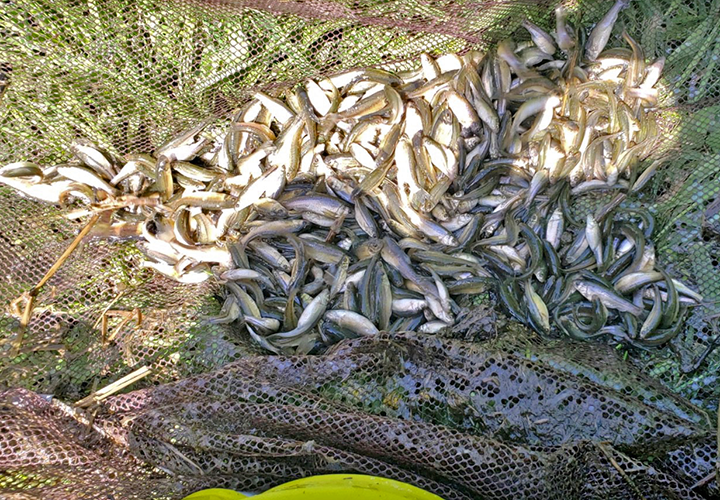 One glaring example occurred yesterday when I ran into an acquaintance in the fish cleaning shack. “We’ve been having a devil of a time getting decent minnows this summer, our supplier just can’t get ‘em”, he said.
One glaring example occurred yesterday when I ran into an acquaintance in the fish cleaning shack. “We’ve been having a devil of a time getting decent minnows this summer, our supplier just can’t get ‘em”, he said.
“That’s funny, I wrote a report recently (September 21, 2022) about a man who has a pond chocked full of big fatheads who was looking for somebody to come and get them. Maybe you should have your distributor get in touch with the man and see if they can’t work out a deal?” I replied. We exchanged some information and went back about our business of cleaning fish.
Now the subject of crappie fishing comes up and the man says, “I’ve been catching a bunch of crappies on Lake Iedaknow, but they’re just so darn small, I’ve gotta release 12 little ones for every keeper I get. I think there were some out on Cutfoot too, I was out there the other day walleye fishing and saw (name withheld) hovering over the top of a spot in deep water. He stayed there all day long, so I’m pretty sure that they were crappie fishing.”
That conversation swerved us back onto a topic from yesterday’s (October 3, 2022) report, the one about a strong, region wide, 2016-year class of crappies. At 6 to 8 inches long, the up-and-coming fish are way too small to be of interest today, but in a year or two, they will be perfect “keepers”; that is, if we don’t kill them all first. Which lead us into another perennial topic, barotrauma, the nasty little problem that occurs when anglers yank fish out of deep water.
Included below are useful links to archived articles about barotrauma and I’d encourage you to read them and learn more about what happens to fish caught in deep water. But for the purposes of this report, I need to repeat one simple reminder. There is no such thing as catch and release fishing in deep water. The deeper you fish, the worse the problem is but even fish caught in moderately deep water, i.e., 20 to 25 feet, can suffer from the negative impacts of barotrauma. Fishing in water depths below 30 feet is akin to issuing death sentences to a high percentage of the fish you’re hauling up.
One way around the problem is to fish on lakes that don’t have deep enough water to cause problems. Take Little Cutfoot for example, that lake gets high pressure from anglers and this fall, it’s chocked full of those tiny, 6-to-8-inch crappies. Still, there are some “keepers” out there and folks are in hot pursuit of them. Along the way, they’re catching lots of the 2016-year class fish and throwing them back. There may not be much sport in catching the little ones, but a least on that lake, with a maximum depth of about 19 feet, those baby fish aren’t dying, at least not because of barotrauma.
A few years back, I began making a list of shallow water lakes that host good populations of crappies and was amazed out how many of them exist right here, in the Itasca Region. You’ll have to do your own homework to find them, but rest assured, if you do, you will.
I know that if I search long and hard, I’ll find some decent crappies, but as much as I love fall crappie fishing, I’ve deliberately cut way back on pursuing them this year. In fact, I’ve got less than a half dozen serious crappie excursions under my belt; that’s unheard of for me.
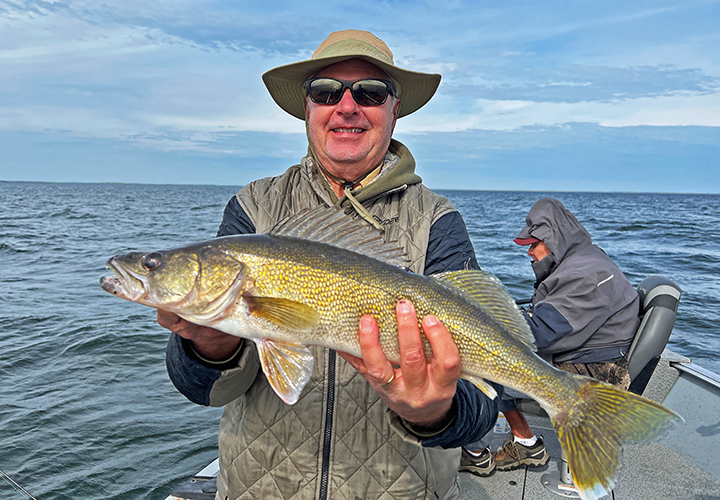 Luckily, walleyes have kept most folks busy enough this fall and now, I’m seeing more alternative opportunities too. Jumbo perch for example, have really started to get active and if you’re on the right lake, so are sunfish. Depending on the weather, on of those panfish species might be worth spending some time on. For me, windy days, especially cloudy ones are ideal perch days. Calm water won’t kill the perch bite completely but will surely slow it down. That’s when fishing for sunfish would be a better idea.
Luckily, walleyes have kept most folks busy enough this fall and now, I’m seeing more alternative opportunities too. Jumbo perch for example, have really started to get active and if you’re on the right lake, so are sunfish. Depending on the weather, on of those panfish species might be worth spending some time on. For me, windy days, especially cloudy ones are ideal perch days. Calm water won’t kill the perch bite completely but will surely slow it down. That’s when fishing for sunfish would be a better idea.
Weeds are still the best location for either of the 2 choices and key water depths have ranged between 6 and 10 feet. For perch, 1/16-ounce Lindy Live Bait Jigs tipped with fatheads is working well. For sunfish, try ice jigs, Tungsten Toads tipped with a waxworm has become a favorite for me. In a pinch though, I can use a jig head tipped with a cut piece of nightcrawler too.
My crew had a great day on Winnie yesterday, the breeze was blowing, the skies were grey, and the surface water temperature was stable at about 58 degrees. Those conditions are about as good as it gets and as you might expect, the walleyes were on the prowl! Headed in the direction of a family fish fry, we harvested a full 3-man limit of walleyes using the voluntary harvest restriction of a 15-inch minimum. Six of the fish were between 15 to 16 inches, all the rest were above 16 inches, including a few 17-1/2 fish from the 2018-year class.
Those fish were the ones I mentioned the other day, walleyes from the 2018-year class that are now getting very close to reaching the protected slot limit. I mentioned my strategy for zeroing in on more of the 2018 fish and harvesting fewer of the 2019-year class fish. For those who care, my running total of fish that have already reached the 18-inch threshold to be placed into protective custody now totals 14 fish. Most of those have been between 18.01 to 18.25 inches in size, making it fairly safe to assume that they were indeed from the class of 2018. The growing season is coming to an end, but I’ll bet that more of those 18 inches, protected fish will come to the landing nets over the next 2 weeks.
On a side note, the heightened activity level has provided opportunity to catch more little fish too. Anecdotally, we’ve seen a fair number of 11-to-12-inch fish and even a health smattering of 7-to-10-inch fish. Indications are favorable that 2021 might have been a good year for walleye production and while it wasn’t great, even 2020 was semi-productive at least. More on that later.
Typical of my early morning ritual, I’ve run up against the clock and have to run. Replacing only what has already been consumed, we won’t need a ton of walleyes today, so will likely branch out and try for perch, maybe even a pike that’s suitable for the coconut pike delight recipe; we’ll see how it goes. ![]() — Jeff Sundin 218-245-9858 or EMAIL
— Jeff Sundin 218-245-9858 or EMAIL
 Jeff Sundin "Peeking at the Peak-Able" October 3, 2022
Jeff Sundin "Peeking at the Peak-Able" October 3, 2022
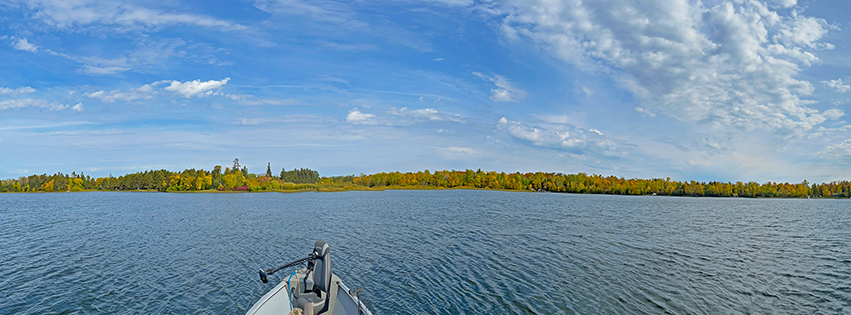 I overheard a conversation between some anglers at the fish cleaning shack last Friday. “Lots of people out there today”, one said. “Oh yeah, the weather is nice, and the word is out about Winnie”, another chimed in. “It’s only gonna get worse from here, pretty soon, there won’t be a place left to fish”, the third angler pontificated. That was the consensus, fishing is so good that you won’t be able to beat people away with a stick.
I overheard a conversation between some anglers at the fish cleaning shack last Friday. “Lots of people out there today”, one said. “Oh yeah, the weather is nice, and the word is out about Winnie”, another chimed in. “It’s only gonna get worse from here, pretty soon, there won’t be a place left to fish”, the third angler pontificated. That was the consensus, fishing is so good that you won’t be able to beat people away with a stick.
Excuse me for being the contrarian in the crowd, but I’ll step out on a limb and say that this was it, the “big peak” weekend just came, and went. There will still be some crowds of anglers out there, the die-hards and hard-core fishing crowd that sticks with it, even when their fingers get numb, and the line guides of their fishing rods begin freezing up. But lots of resorts are around the area, including some on Lake Winnie shut their doors after this weekend. Many more will do so after the upcoming weekend and soon, there won’t be many places to rest overnight, let alone to clean a fish, or launch a boat and so on. Many of the guides are hanging it up for the season too, moving along to hunting gigs or “their real jobs” or in other cases, just turning their attention to relaxation after a hectic summer.
Oh, and by the way, yes, the “word” definitely is out about Winnie. It has been for most of the summer. I’m afraid all of that good news has overshadowed some great stories about other Itasca Region lakes where there is equally good fishing going on right now too. On Leech Lake for example, anglers with “the knack” for finding walleyes are crushing them right now. The jig and minnow bite are working, and the action has been reliable. Walleyes, as evidenced by the crowd at the Hwy 2 boat ramp in Cass Lake this weekend, have been on the prowl too, so have the jumbo perch.
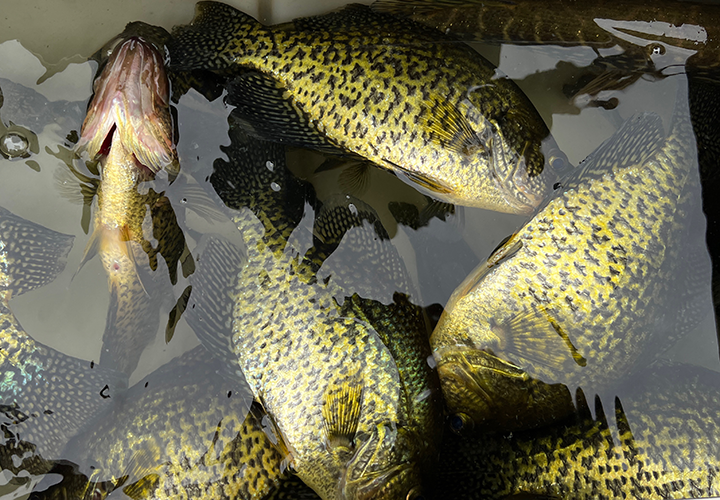 With area-wide surface water temperatures ranging between 57 and 60 degrees, most of the well-known “fall lakes”, ones that typically offer productive fall fishing have experienced upticks in fish activity. The ones that haven’t, can’t blame it on the weather, in those waters, dips in fish populations are more likely the trouble.
With area-wide surface water temperatures ranging between 57 and 60 degrees, most of the well-known “fall lakes”, ones that typically offer productive fall fishing have experienced upticks in fish activity. The ones that haven’t, can’t blame it on the weather, in those waters, dips in fish populations are more likely the trouble.
Fish populations everywhere vary from one season to another, they always have. But with anglers’ improved knowledge, locating and catching them is easier than before. Add that to most folks having the mobility and free time to act on good news fast, the effects of peaks and valleys in fish populations are more noticeable these days. These days, flying under the radar takes more effort than it used to, I have to work a lot smarter at being the first one to scout out fresh territory. That said, if I do, work smarter that is, it will pay off after a few tries and when it does, it’s a lot of fun.
So, I guess this in my perennial sales pitch about using the next couple of weeks, if you have the time, to go out and explore. With most resorts closed and casual anglers hanging up their fishing rods for the season, there will be more free space on some of the lakes where good fishing has gone under-reported this summer. Add to that that this is the time when fish are naturally biting, feeding heavily in preparation for winter; it’s a good time for us Amerigo Vespucci types to go out and research fresh territory.
You’ve likely noticed that crappies, especially in some of the lakes that were popular in recent years, are in a low ebb. A DNR Biologist friend of mine gave credence to my suspicions that the bubble is sort of an area-wide re-building process. Unlike other panfish, crappies do not successfully spawn every spring. They might try, but if something goes wrong with the weather, they’ll abandon their beds and most times, will not return. That means there can be a year, or sometimes a series of years when there is not a strong year class.
The population gaps, combined with angling pressure and natural predation are what sometimes causes a steady decline in crappie activity in your favorite lakes. Eventually though, spring conditions are good, and the spawning season is a hit. Apparently, 2016 was one of those good spawning seasons and those fish are beginning to mature.
There have been several times this fall when we have stumbled into fish from that successful spawning season, and it happened again yesterday Crappies in the 7-to-9-inch range showed up on a lake that I re-visited after a long pause. I used to fish this lake frequently and I’m sure these fish will grow larger soon but weren’t quite up to keeper size yet. There was a smattering of keepers, we harvested 6 fish that were 10-1/2 inches and 3 that were over 11 inches, but fell 1 fish short of Ken’s legal, 10 fish limit. Next year, those fish will all be entering the keeper zone and so will many of the fish that we’ve caught on other area lakes this fall.
With a couple more weeks of guiding still on the books, I’m not quite off the hook in terms of having to all the free time I need to explore. But I do plan on sprinkling more experimentation into the trips I have scheduled and after I work around the days that I have to “play it safe” for the walleyes or die crowd, I’ll be adding, or attempting to add a few new crappie lakes to the repertoire for the upcoming ice fishing season. As I do that, I’ll compare notes with more of the DNR biologists and let you know what I learn.
If you hung up your fishing pole after this past season, good luck with whatever you do next. But if you’re like me, hanging in there for a few more weeks, keep checking the reports, I’ll be on duty most days until October 20th. After that, I hope to grab my own shotgun and my dog and do whatever I can figure out to do in the fields. ![]() — Jeff Sundin 218-245-9858 or EMAIL
— Jeff Sundin 218-245-9858 or EMAIL
You Are Invited To Become A Duly Deputized Fishrapper Cub Reporter
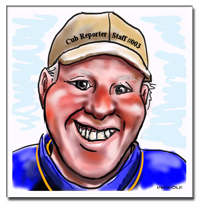 If you've been waiting for a gold engraved invitation to participate in the daily reports, then stop waiting and consider this your own personal invitation.
If you've been waiting for a gold engraved invitation to participate in the daily reports, then stop waiting and consider this your own personal invitation.
Helping your fellow fishermen and women stay abreast of fishing conditions in your area is good for everybody and it's easier than you think! You don't have to write a book, you don't have to share your secret fishing spots and you don't even have to mention your lake. But even a few words about general trends, seasonal patterns and local weather conditions can really help.
Be like me, become a duly deputized "Cub Reporter", it's good for fishing! Contact Us or if you prefer to be "social", Fishing Reports Minnesota, the Facebook counterpart to this page is open to the public, so you can post your own fishing update or just share a photo of a nice catch.